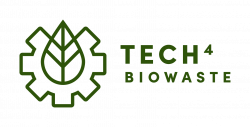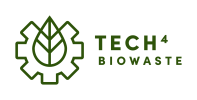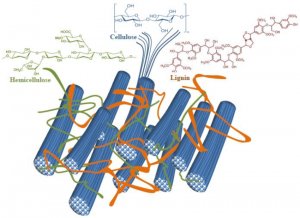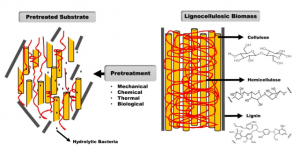Enzymatic processes
| Technology | |

| |
| Technology details | |
| Name: | Enzymatic processes |
| Category: | Conversion (Biochemical processes and technologies) |
| Feedstock: | Garden and park waste |
| Product: | Cellulose, hemicellulose, lignin |
Enzymatic processes utilise enzymes (/ˈɛnzaɪmz/) which are proteins that act as biological catalysts (biocatalysts).[1] In terms of lignocellulosic biomass valorisation, enzymes find two main applications: i) biomass pretreatment, and ii) polysaccharides hydrolysis. Biomass enzymatic pre-treatment falls under the category of "biological pre-treatment". Other pre-treatment methods for lignocellulosic biomass includes, physical (e.g., mechanical), chemical (e.g., acid and alkali), physico-chemical (e.g., steam explosion and AFEX), and a combination thereof[2]. polysaccharides hydrolysis is a concept mostly applied in biorefineries as part of the hydrolysis of plant cell wall constituents like cellulose, hemicellulose, and lignin.
Feedstock
Origin and composition
Lignocellulosic biomass (LCB) can be collected as a waste material from forest residues, agricultural, and industrial activities. LCB is mainly characterized by the presence of two carbohydrate polymers, namely cellulose and hemicellulose, as well as an aromatic polymer called lignin. Other components in LCB, found in smaller amounts, are ash, pectin, and proteins. The percentage content of celluloce, hemicelllulose, and lignin are varied among different lignocellulosic materials. In general, the content of cellulose, hemicellulose, and lignin in LCB is in the range of 30-60%, 20-40%, and 15-25%, respectively.[3] The physical appearance and strenght of the biomass depend on the varying concentration of these polymers and therefore greatly influences the type of pre-treatment strategy applied for its deconstruction.
Structural features LCB:
Cellulose
Cellulose is a polysaccharide polymer of glucose disaccharide units, cellobiose, linked tightly by ß-1,4-glycoside bonds. Cellulose molecules are linked by hdyrogen bonds and have different orientations resulting in different levels of crystallinity. Its crystallinity plays a crucial role in the biodegradation of cellulose and, in general, the higher crystallinity level makes it harder to biodegrade the cellulose.
Hemicellulose
Hemicellulose is a random and branched heterogeneous polymer of different polysaccharides including pentoses (xylose and arabinose), hexoses (glucose, galactose, and mannose) and sugar acids. The branched nature of the hemicellulose allows it to form strong bonds with cellulose (through hydrogen bonds) and lignin (through covalent bonds).
Lignin
Lignin is a complex and large compound made out of phenylpropane units linked in a three-dimensional structure. The main monomers of lignin are p-hydroxyphenyl alcohol, coniferyl alcohol, and sinapyl alcohol. Lignin acts as a cementing material that links celluose and hemicellulose to form the rigid three-dimensional structure of the plant cell wall.
Pre-treatment
The following pre-treatments may be considered prior to enzymatic pre-treatment:
- Sizing (e.g., milling, grinding)
- Steam explosion (hybrid pre-treatment; e.g., combined with laccase pretreatment)[4]
The following pre-treatments may be considered prior to enzymatic hydrolysis[5],[6]:
- Physical (e.g., milling, grinding, ultrasonication, extrusion)
- Chemical (e.g., acid, alkali, ionic liquid, organosolv)
- Physico-chemical (e.g., steam explosion, hot water, AFEX, wet oxidation)
- Biological (e.g., microbial and enzymatic)
Process and technologies
Enzymatic pre-treatment (biological pre-treatment)
Biological pre-treatment systems rely on biological agents (e.g., enzymes) to delignify lignocellulose and make the process of enzymatic hydrolysis more convenient. The effect of enzymes on the lignocellulosic biomass depends on the type of enzymes as well as the composition of the biomass being treated. This is due to enzyme specificity in terms of the type of the reactions that they catalyze. Laccase (Lac), manganese peroxide (MnP) and versatile peroxide (VP) are enzymes that are used extensively to treat the lignocellulosic substrate[7]. Biological pre-treatment of LCB is often knows as a simple, inexpensive, selective, and environmentally-friendly technology. This is mainly due to the fact that biological pre-treatment does not require high energy inputs or chemicals addition. Furthermore, enzymatic treatment has found success in the removal of toxic inhibitory compounds (i.e., complete removal of phenolic compounds). The limitations asociated with enzymatic pretreatment is its production cost, stability, shelf life, and reusability[6].
Enzymatic hydrolysis
Enzymatic hydrolysis processes allow to produce monomeric sugars from (ligno)cellulosic biomass by using specific enzymes (e.g., cellulases and hemicellulases) able to break down the chemical bonds in cellulose and hemicellulose polymers. Several factors can affect the efficiency of this process: accessible surface area and crystallinity of the biomass, as well as pH, time and temperatures of the process[8]. Enzymatic hydrolysis is gaining increased attention with respect to acid hydrolysis due to equipment corrosion, energy consumption, non-recyclability of reagents, and fermentation inhibitors production during acid hydrolysis [9]. Different enzymes play different roles in the hydrolysis of lignocellulosic biomass:
Cellulases
Cellulases are one of the key enzymes in biomass hydrolysis. Cellulases are a family of enzymes that synergistically act on cellulose to hydrolyze it to its monomers. Cellulases acts on the ß-1,4-glycosidic linkages in cellulose. The complete hydrolysis of cellulose is mediated by combination of three main cellulases, namely endoglucanases (EC 3.2.14), exoglucanases (EC 3.2.1.91), and glycosidase (EC 3.2.1.21). T. reesei-based cellulases have been the focus of research for the past several years and are widely used in laboratory- as well as pilot-scale studies for bioethanol application. Most commercially accessible enzymes for biomass hydrolysis are actually cocktails of cellulases from Trichoderma or Aspergillus supplemented with ß-glucosidases from other sources.
Hemicellulases
Hemicellulose consists of a mixture of glucose and sugar monomers. Xylan is the most abundant hemicellulose-containing pentose sugars, such as xylose. The enzyme xylanase helps to catalyze the hydrolysis of xylan. Hydrolysis of xylan is mediated by the action of multiple xylanases (i.e., endoxylanases and exoxylanases). Commercially, xylanases are produced from T. reesei, A. niger, humicola insolens, and Bacillus sp.
Pectinases
Pectinase is a complex enzyme that degrades the pectin present in lignocellulosic biomass. Pectin is a polymer of α-1,4-linked D-galacturonic acid. This enzyme breaks down polygalacturonic acid (GalA) into a monomeric unit by opening glycosidic linkages. It helps the softening of biomass and therefore aids in the hydrolysis of biomass.
Other accessory enzymes
The accessory enzymes are also a crucial part in the hydrolysis of LCB and enhance the hydrolysis yield and reduce the enzyme cost and dosages. The breakdown of hemicelluloses is further accompanied by the addition of ß-xylosidases which produces a final product of oligomer with different length as intermediates. Another important accessory enzyme is α-arabinofuranidase for breaking down arabinose into monomers of furanose and pyranose.
Product
Products enzymatic pre-treatment:
- Cellulose
- Hemicellulose
- Lignin
Potential products after fermentation:
- Bioethanol
- Biodiesel
- Biobutanol
- Methane
- Specialty chemicals
Post-treatment
Currently no post-treatment has been identified.
Technology providers
| Company name | Country | Technology subcategory | Technology name | TRL | Capacity [kg/h] | Processable volume [L] | Temperature [°C] | Feedstock: Food waste | Feedstock: Garden & park waste |
|---|---|---|---|---|---|---|---|---|---|
| MetGen Oy | Finland | - | METNIN™ | 8 | 3 | - | 50 | ● | ● |
| NovelYeast bv | Belgium | - | Enzymatic saccharification, In-situ enzyme production | 3-5 | - | 5 | 25-60 | ● | ● |
| University of Naples (Naples, Italy) | Italy | - | Enzymatic Hydrolysis | 2-4 | - | - | - | ● | ● |
MetGen Oy
| General information | |||
| Company: | MetGen Oy | 
| |
| Country: | Finland | ||
| Contact: | alex@metgen.com | ||
| Webpage: | www.metgen.com | ||
| Technology and process details | |||
| Technology name: | METNIN™ | Technology category: | Conversion (Biochemical processes and technologies) |
| TRL: | 8 | Capacity: | 50 kg/week (lignin) kg·h-1 |
| Agitator: | Rushton turbine | Controlled parameters: | Temperature, pressure, air flow, pH, DS |
| Processable volume: | 3 tonnes L | Reactor: | Steel Reactor |
| Reactor material: | Acid durable steel quality S 316 | Safety restrictions: | |
| Temperature: | 50 °C | Other: | |
| Feedstock and product details | |||
| Feedstock: | Lignin (waste stream in pulp and paper industries and biorefineries) | Product: | METNIN™ SHIELD - a sustainable BIO-BASED additive for fiber-based packaging boards. |
MetGen has developed and commercially launched a novel lignin valorization technology, METNIN™ to valorize the underutilized lignin streams from modern biorefineries, and pulp and paper mills. METNIN™ is a unique market driven technology combines affordable engineering with advanced biotechnology and turns abundant industrial side stream into sustainable and recyclable alternatives for petrochemicals.
Potentially, the technology produces three main products such as METNIN™SHIELD for additives in packaging applications, METNIN™ lignopolyols in polyurethane application, METNIN™ resins for plywood adhesives. The technology is lignin agnostic and provides the missing link in the value-chain between crude lignin and high value lignin fractions for specific end user products. MetGen’s near-term goal is to accelerate the commercialization of METNIN™ technology and widen the bio-based products’ to market as fast as possible. This will open new opportunities for biorefinery lignin valorization thus paving the way for sustainable and more cost-efficient biorefinery business model. Currently, MetGen is in progress of bringing METNIN™ technology from pilot to demonstration scale with potential to reduce GHG emission by 85%.
METGEN is one of the leading innovators in creating and developing bio-based technologies. Our mission is to enable industries to enhance the value of lignocellulosic biomass through enzymatic solutions. MetGen addresses the demand for creating more sustainable production solutions, helping to meet the ever-growing desire to increase sustainability, reduce environmental pollution, minimize the carbon footprint and conserve biodiversity.
The switch to bio-based feedstocks allows the chemical industry to cut dependency on finite fossil feedstocks and increases the use of more resource-efficient biobased technologies. MetGen is at the core of this development. MetGen produces enzymes on an industrial scale, providing commercial enzymatic solutions to modern biorefineries and the pulp & paper and biogas industries. Our philosophy is to design enzymes for maximum impact in real-life process conditions.
After taking science from the labs to the brink of building factories, it is time to share a few experiences along the way. Innovation comes in many layers and MetGen’s presentation unravels the entangled enzymes, processes, chemistries, bio-products, financing, and business models to a more crisp view of the future of the bio-economy.
MetGen’s business model for METNIN™ technology and other enzymatic technologies is 2-fold: manufacturing and licensing of technologies. The market is too wide for any one company to capture alone and the societal and environmental impact can only be maximized through a parallel business model, licensing. MetGen shall produce the material on its own but also license the METNIN™ technology to be integrated into various types of biorefineries. This project will support and lay the foundation for both business avenues.
As the METNIN™ technology is lignin-agnostic, there are vast opportunities for future commercial replication. METNIN™ is a platform technology and can be operated independently to serve the entire industry. Production of large volumes of products maximizes the value of the technology. Even though the plant can be built next to an existing producer of lignin and take advantage of the synergies in utility sourcing as well as the chemicals recycling, the business model is best served if the operations are not dependent on any one operator of a source of raw material. The low energy demand for operations allows the facility to be located also as a stand-alone establishment. MetGen has received many indications of interest to co-locate the facility by the industry, showing the future expansion potential. The technology is modular, hence leaving flexibility for capacity scale-up to be realized after achieving the expected performance and up-time by first fractionation module.
METNIN™ technology can be used as a stand-alone operational unit but can also be integrated in existing P&P mills and Biorefineries.
LCA study has been carried out using third party services. METNIN™ technology demo plant with 3 selected products shows an emission reduction potential of 85% greenhouse gases (GHG) reduction compared to the fossil based manufacturing of the same products.
NovelYeast bv
| General information | |||
| Company: | NovelYeast bv | 
| |
| Country: | Belgium | ||
| Contact: | johan.thevelein@novelyeast.com | ||
| Webpage: | https://www.linkedin.com/in/johan-thevelein-aab60a10/ | ||
| Technology and process details | |||
| Technology name: | Enzymatic saccharification, In-situ enzyme production | Technology category: | Conversion (Biochemical processes and technologies) |
| TRL: | 3-5 | Capacity: | Lab scale kg·h-1 |
| Agitator: | Shake flasks, magnetic stirring | Controlled parameters: | Standard parameters |
| Processable volume: | 5 L | Reactor: | Shake flasks, static tubes with magnetic stirring |
| Reactor material: | Glass | Safety restrictions: | Standard microbiological practice |
| Temperature: | 25-60 °C | Other: | Application of commercial enzyme cocktails, development of in situ enzyme production |
| Feedstock and product details | |||
| Feedstock: | 1G and 2G feedstocks | Product: | Fermentable sugars |
NovelYeast bv was founded in 2019 by Prof. Johan Thevelein (KU Leuven and VIB) to continue his R&D activities after his retirement in 2020 as emeritus. The company focusses on the development and industrial implementation of yeast cell factories for the production of biofuels, bio-based chemicals as well as specialty sugars and ingredients with first- and second-generation feedstocks. It also develops cell factories for the production of specific proteins for food applications and enzymes for saccharification of lignocellulosic biomass. In addition, it uses yeast as a tool for biomedical and agroindustrial applications, including yeast probiotics and anti-cancer drugs selected by screening in yeast. NovelYeast has several R&D service collaborations with companies world-wide. Specific industrial yeast strains are available from NovelYeast for the production of 2G bioethanol with lignocellulosic biomass hydrolysates, the production of 1G 2,3-butanediol with first-generation sugars, the production of 1G isobutanol with first-generation sugars, the production of 2G isobutanol with lignocellulosic biomass hydrolysates, the production of 1G bioethanol with molasses, the production of lactic acid with first-generation substrates, the production of isomaltulose with sucrose as substrate. Other yeast strains are in development.
University of Naples (Naples, Italy)
| General information | |||
| Company: | University of Naples "Federico II"; Department of Chemical Sciences | 
| |
| Country: | Italy | ||
| Contact: | Professor Vincenza Faraco, PhD
Department of Chemical Sciences Via Cintia, 4 IT-80126 Napoli | ||
| Webpage: | https://www.docenti.unina.it/vincenza.faraco | ||
| Technology and process details | |||
| Technology name: | Enzymatic Hydrolysis | Technology category: | Conversion (Biochemical processes and technologies) |
| TRL: | 2-4 | Capacity: | not relevant kg·h-1 |
| Agitator: | not relevant | Controlled parameters: | not relevant |
| Processable volume: | not relevant L | Reactor: | not relevant |
| Reactor material: | not relevant | Safety restrictions: | not relevant |
| Temperature: | not relevant °C | Other: | not relevant |
| Feedstock and product details | |||
| Feedstock: | 1G and 2G feedstocks | Product: | Fermentable sugars |
The Department of Chemical Sciences of University of Napoli Federico II hosts about 100 researchers and 20 units of technicians and administrative personnel. The main activities of the Department are the Research, the Didactics and the so-called third mission activitities. The Research activities cover several areas of Chemistry, including the design and synthesis of new molecules, from low mass to macromolecules, the purification and the analytic characterization of natural and synthetic molecules, the structural characterization of new molecules through X-ray diffraction, nuclear magnetic resonance, optical and spin electron spectroscopy techniques, mass spectroscopy. The design, the synthesis and the characterization of new molecules are aimed, for example, to the production of innovative molecules with catalytic properties in important chemical and polymerization processes, or to the production of new functional materials, for several applications in a wide range of fields. Research activities also regard the study of biomolecules and biopolymers for applications in biotechnology, from the development of biosensors to biomedical applications, the study of organic functional molecules and organic polymers for special applications, such as the microelectronics, or the development of new materials with innovative mechanical properties, and the study of nanostructured materials for applications in several fields going from the biology to the medicine, from microelectronics to nanophotonics.
The Department of Chemical Sciences offer the following study programmes:
- Bachelor Degree in Chemistry
- Master Degree in Chemistry
- Bachelor Degree in Industrial Chemistry
- Master Degree in Science and Technology of the Industrial Chemistry
- Bachelor Degree in Molecular and Industrial Biotechnologies
- Master Degree in Molecular and Industrial Biotechnologies
The Department of Chemical Sciences offers the following PhD Courses:
- PhD Course in Chemical Sciences
Open access pilot and demo facility providers
Patents
Currently no patents have been identified.
References
- ↑ , 2021: Enzyme , Last access 24-09-21. https://en.wikipedia.org/wiki/Enzyme
- ↑ E. Hosseini Koupaie, S. Dahadha, A.A. Bazyar Lakeh, A. Azizi, E. Elbeshbishy, 2018: Enzymatic pretreatment of lignocellulosic biomass for enhanced biomethane production - A review. Journal of Environmental Management, Vol. 233, 774-784. doi: https://doi.org/10.1016/j.jenvman.2018.09.106
- ↑ Sawatdeenarunat, C., Surendra, K., Takara, D., Oechsner, H., Khanal, S.K., 2015: Anaerobic digestion of lignocellulosic biomass: challenges and opportunities. Bioresour. Technol., Vol. 178, 178-186. doi: https://doi.org/10.1016/j.biortech.2014.09.103
- ↑ Weihua Qiu, Hongzhang Chen, 2012: Enhanced the ezymatic hydrolysis efficiency of wheat straw after combined steam explosion and laccase pretreatment. Bioresource Technology, Vol. 118, 8-12. doi: https://doi.org/10.1016/j.biortech.2012.05.033
- ↑ Rajeev Ravindran, Amit Kumar Jaiswal, 2016: A comprehensive review on pre-treatment strategy for lignocellulosic food industry waste: Challenges and opportunities. Bioresource Technology, Vol. 199, 92-102. doi: https://doi.org/10.1016/j.biortech.2015.07.106
- ↑ a b Bikash Kumar, Nisha Bhardwaj, Komal Agrawal, Venkatesh Chaturvedi, Pradeep Verma, 2019: Current perspective on pretreatment technologies using lignocellulosic biomass: An emerging biorefinery concept. Fuel Processing Technology, Vol. 199, . doi: https://doi.org/10.1016/j.fuproc.2019.106244
- ↑ Baruah J., Nath B.K., Sharma R., Kumar S., Deka R.C., Kalita E., 2018: Recent Trends in the Pretreatment of Lignocellulosic Biomass for Value-Added Products. Front. Energy Res., Vol. 141, . doi: https://doi.org/10.3389/fenrg.2018.00141
- ↑ Saverio Niglio, Alessandra Procentese, Maria Elena Russo, Giovanni Sannia, Antonio Marzocchella, 2019-06-01: Investigation of Enzymatic Hydrolysis of Coffee Silverskin Aimed at the Production of Butanol and Succinic Acid by Fermentative Processes. BioEnergy Research, Vol. 12, (2), 312–324. doi: https://doi.org/10.1007/s12155-019-09969-6
- ↑ Gabriela Piccolo Maitan-Alfenas, Evan Michael Visser, Valéria Monteze Guimarães, 2015-02-01: Enzymatic hydrolysis of lignocellulosic biomass: converting food waste in valuable products. Current Opinion in Food Science, Vol. 1, 44–49. doi: https://doi.org/10.1016/j.cofs.2014.10.001

